2. 云南省农业科学院农业环境资源研究所, 昆明 650201
2. Institute of Agricultural Environment and Resources, Yunnan Academy of Agricultural Sciences, Kunming 650201, China
化肥对促进作物生长,保证作物高产、稳产具有重要作用[1]。中国是世界上最大的化肥生产和消费国,在2013年,我国农用化肥消耗量达到了5 911.9万t,超过世界化肥消耗总量的1/3。2014年,我国耕地化肥施用量为447.2 kg·hm-2,远超过仅为125.5 kg·hm-2的世界平均化肥施用量[2]。我国每年氮肥施用量为3 360万t,占全球的33%,导致农田氮盈余量已达到175 kg·hm-2[3]。大量化肥投入造成土壤氮盈余,这不仅污染大气和水体,也造成资源浪费。
在我国华北平原小麦-玉米轮作体系中,每年氮肥投入量为588 kg·hm-2,远高于其他国家氮肥施用量[4]。有研究指出,对高化肥投入量的农田,适量的减施化肥不会影响作物产量[5],且能显著减少土壤氮盈余[6]。赵亚南等[6]研究指出,在氮肥用量从180 kg·hm-2减为96 kg·hm-2时,小麦产量并未减产,且提高了肥料利用率。另外,畜禽粪便中含有丰富的氮资源。据统计,我国2015年畜禽粪尿中氮产生量为1 229万t[7]。与单施化肥相比,有机肥能提高土壤微生物多样性,提高微生物和酶活性,降低土壤容重,改善土壤结构,活化土壤养分等[8-9]。畜禽粪便经厌氧发酵后产生的沼气可作为能源物质,沼液可作为一种液体有机肥还田再利用。有研究表明单施化肥与50%的沼液替代相比对玉米产量并无显著差异[10],而王桂良等[11]研究指出小麦产量在50%的沼液替代时产量最高。沼液和化肥合理配施能提高作物产量,增加土壤有机质和土壤氮、磷、钾等速效养分含量[11-13]。目前的研究大多只是单独研究化肥减量或者有机无机配施,而化肥减量与沼液配施相结合对于大田作物生长和环境影响特征的研究相对较少。
华北平原属于暖温带季风气候,冬季干燥寒冷,夏季高温多雨,年降水量为500~900 mm,但区域间差异大,如在河北省中南部降雨量<500 mm。施肥和降水是影响农田氮流失的主要因素。农田地下淋溶和地表径流是氮素进入水体的主要方式。在旱地作物中,氮淋溶流失量要高于径流流失量。段然等[5]研究指出,土壤氮素径流流失量低于0.70 kg∙hm-2,而氮素淋失量却远高于此[14-15]。有研究表明大量施用氮肥必将导致土壤中硝态氮大量淋失[16]。与单施化肥相比,有机无机配施能降低农田总氮、硝态氮和铵态氮淋失量[17-18]。有机肥能够改善土壤理化性质,增加土壤孔隙度,增强渗透性,提高土壤容纳雨水能力,减少氮素流失[19]。
本研究为了保证华北平原小麦、玉米产量的可持续性,探讨了在减施化肥条件下,单施化肥和部分有机替代对于作物产量和氮流失的影响,以期为化肥合理减施提供科学依据。
1 材料与方法 1.1 试验地概况本试验地位于河北省正定县新安镇(38°14.29′ N,114°34.52′ E),土壤类型为黄褐土,质地为中壤。平均海拔为78 m,年平均气温为13.1 ℃,年平均降雨量为489 mm,属于黄淮海半湿润平原,种植模式为冬小麦-夏玉米轮作。冬小麦生育期为每年10月初到次年6月初,夏玉米生育期为每年6月中旬到10月初。试验开始时土壤(0~20 cm)基础理化性质为:土壤容重1.24 g·cm-3,pH 7.5,有机质21.5 g·kg-1,总氮0.91 g·kg-1,总磷0.75 g·kg-1,有效磷24.1 mg·kg-1,硝态氮12.9 mg·kg-1,铵态氮0.74 mg·kg-1。
1.2 试验设计试验始于2014年,设置3个处理:(1)CON,常规施肥;(2)RF,化肥减量;(3)RFM,化肥减量替代(10%沼液+90%化肥减量)。沼液取自试验田附近养殖场,年投入量为22.5 t·hm-2。各处理具体施肥量见表 1。氮肥50%作基肥,50%作追肥施入农田,磷、钾肥和沼液于每年的10月初玉米收获后和小麦种植前一次性施入土壤。每个处理设3个重复,小区面积为36 m2(8 m×4.5 m)。根据小麦和玉米生长状况进行灌溉,2015年和2016年小麦生育期灌溉2次,分别在返青拔节期和灌浆乳熟期;玉米生长期灌溉1次,在出苗时期。2017年小麦生育期灌溉3次,分别在苗期、返青拔节期和灌浆乳熟期;玉米生长期灌溉2次,分别在出苗期和乳熟期。灌溉方式为沟灌,每次灌溉量均为125 mm。小麦、玉米品种分别为衡4399和星硕F1。在小区地下90 cm处安装淋溶液收集桶,用于收集每次降雨或灌溉产流后的渗滤液。田间径流水收集池长4.5 m、宽1.0 m、深1.5 m,用于收集每次径流产流水样(图 1)。
|
|
表 1 不同处理具体施肥量 Table 1 Amount of fertilizer application under different treatments |

|
图 1 田间淋溶水(a)和径流水(b)收集装置 Figure 1 The collection devices of leaching(a)and runoff (b)in cropland |
每年在玉米收获后,用直径5 cm的土钻在每个小区多点随机采集0~100 cm土样,每20 cm为一层,混匀并装在密封的塑料袋中,用于进一步分析。每年6月和10月小麦、玉米收获时采集一定面积植株样,风干、脱粒,计算籽粒和秸秆干物质量。在每次灌溉或降雨产流后测量渗滤液和径流水体积,并取100 mL水样放置于-20 ℃冰箱中冷冻保存,用于进一步分析。及时清空剩余的渗滤液和径流水,避免干扰下一次采样。
水样中的总氮用紫外分光光度计测定,可溶性总氮、硝态氮和铵态氮浓度用连续流动分析仪(AA3)分析。土壤含水率采用烘干法,土壤有机质采用重铬酸钾容量法,土壤全氮采用凯氏定氮法,土壤全磷采用H2SO4-HClO4消煮,有效磷采用0.5 mol·L-1 NaHCO3溶液浸提-钼锑抗比色法,硝态氮采用0.01 mol·L-1 CaCl2溶液浸提,连续流动分析仪(AA3)测定。作物收获后,用H2SO4-H2O2消煮,凯氏定氮法测定小麦、玉米籽粒和秸秆中全氮含量[20]。
氮盈余(kg·hm-2)=施氮量+降雨氮输入量+灌溉氮输入量-(作物吸氮量+氮淋溶淋失量+氮径流流失量)
氮表观流失率(%)=氮淋失量(径流流失量)/施氮量×100%
水体氮损失排放强度(kg N·Mg-1)=(氮淋失量+氮径流流失量)/作物产量
氮淋失量计算公式:

|
式中:NL为总氮、可溶性总氮、硝态氮或铵态氮淋失总量,kg·hm-2;n为淋溶发生次数;NLCi为总氮、可溶性总氮、硝态氮或铵态氮淋失浓度,mg·L-1;Vi为每次淋溶发生时淋溶水体积,L;1.2为淋溶收集面积,m2。
氮径流流失量计算公式:

|
式中:NR为总氮、可溶性总氮、硝态氮或铵态氮径流流失总量,kg·hm-2;n为径流发生次数;NRCi为总氮、可溶性总氮、硝态氮或铵态氮流失浓度,mg·L-1;Vi为每次径流发生时径流水体积,L;4.5为径流池面积,m2。
1.4 数据处理与分析运用Microsoft Excel 2016进行数据分析、处理和绘图,运用SPSS 22单因素方差分析进行显著性检验,LSD法进行均值比较。
2 结果与分析 2.1 作物产量根据3 a的试验结果,CON与RF、RFM处理相比,小麦和玉米产量差异均不显著(P>0.05)(图 2),CON、RF、RFM 3个处理小麦年均产量分别为9 234、9 068、9022 kg·hm-2,玉米年均产量为9 701、9 555、9 822 kg·hm-2。适当减施化肥不会显著降低作物产量,且配施沼液能提高玉米产量。
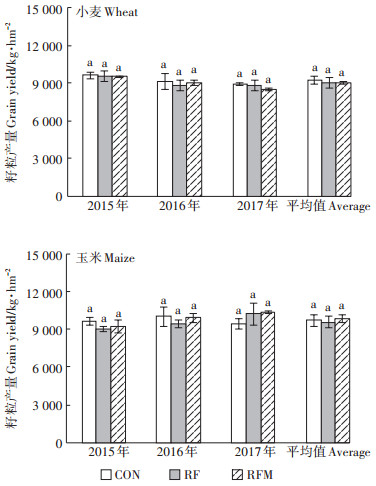
|
图中小写字母的异同分别表示处理间在0.05水平是否存在显著差异。下同 The same or different lowercase letters in the figure indicate whether there is significant difference among treatments(P < 0.05). The same below 图 2 不同年份各施肥处理小麦和玉米籽粒产量 Figure 2 Grain yield of wheat and maize under different treatments in different years |
研究区域灌溉和降雨多发生在4—10月,该时段是淋溶发生的主要时期。在此期间,CON、RF和RFM处理的氮素流失浓度随月份增长而先增加后降低,其中7月和8月是最高时期。CON、RF和RFM处理的总氮浓度变化范围为2.00~109.64、3.35~70.55 mg·L-1和4.30~53.10 mg·L-1,平均值为33.70、23.10 mg·L-1和20.00 mg·L-1(图 3)。与CON处理相比,RF和RFM处理平均总氮淋失浓度分别降低了31.45%和40.65%。总氮淋溶浓度峰值出现在施肥后发生灌溉或连续降雨的时期。CON处理淋溶水中总氮淋失浓度显著高于RF和RFM处理(P<0.05),其中,RFM处理降低氮淋溶效果最佳。
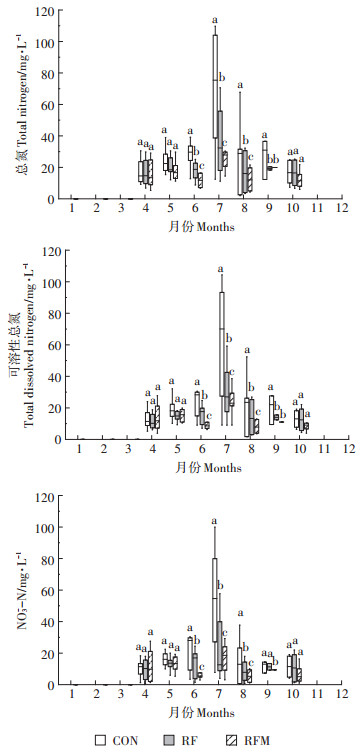
|
图 3 不同月份淋溶水总氮、可溶性总氮和硝态氮浓度变化 Figure 3 Dynamics of total nitrogen(TN), total dissolved nitrogen (TDN)and NO3--N concentration in leachate water during the different months |
不同处理总氮、可溶性总氮和NO3--N淋失浓度变化趋向一致(图 3)。全年间淋溶水总氮、可溶性总氮和NO3--N呈现先增加后降低的趋势。7月和8月是氮素淋溶浓度最高的时期,且氮素浓度波动较大。7月,CON处理总氮、可溶性总氮和NO3--N平均浓度分别为68.47、60.12 mg·L-1和52.37 mg·L-1,均显著高于RF和RFM处理(P<0.05)。根据地下水质量标准(GB/T 14848—2017),仅有CON处理7月淋溶水NO3--N平均浓度超过30.00 mg·L-1,达到了Ⅴ类水标准,由此可见,化肥减量和化肥减量替代能够有效降低土壤NO3--N淋失风险。
CON处理总氮淋失量为22.01 kg·hm-2,显著高于RF和RFM处理(P<0.05)(图 4),和CON相比,RF和RFM处理总氮淋失量减少了30.58%和43.39%。CON处理的可溶性总氮和NO3--N淋失量均显著高于RF和RFM处理,而RF和RFM处理间无显著差异。和CON处理相比,RF和RFM处理可溶性总氮淋失量分别降低了30.70%和42.46%,NO3--N淋失量分别降低了34.46%和45.95%。各处理NH4+-N淋失量一直维持在一个较低的水平,且无显著差异。常规施肥极大增加了氮素淋失量,相较于化肥减量,化肥减量替代能更有效地降低氮素淋失量。
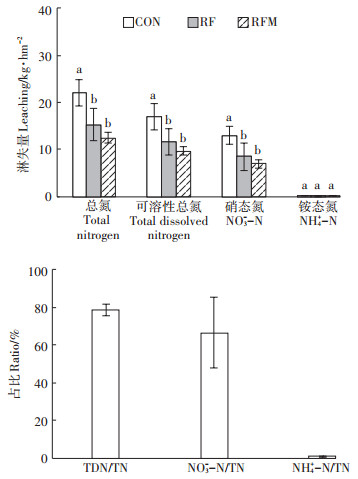
|
图 4 总氮、可溶性总氮、硝态氮和铵态氮年均淋失量 Figure 4 Average annual leaching of total nitrogen(TN), total dissolved nitrogen (TDN), NO3--N and NH4+-N |
淋溶水中可溶性总氮占总氮淋失量的78.56%,NO3--N占总氮淋失量的66.31%,NH4+-N占总氮淋失量的0.83%(图 4)。淋溶水总氮主要为可溶态,NO3--N是总氮的主要淋失形态。
2.3 农田氮素径流浓度和流失量变化3年研究期间地表径流产流次数仅为2次。在产流前两周内分别有3次和4次降雨,多次的降雨导致土壤水处于饱和状态,促使径流产生。在第一次产流时,CON处理总氮浓度显著高于RF和RFM处理(P<0.05)。而在第二次产流时,由于降雨量较小,且远离施肥期,各处理径流水中总氮浓度无显著差异。
全年仅有7月产生了径流,且氮素浓度波动较大(图 5)。7月,CON处理总氮、可溶性总氮和NO3--N平均浓度分别为23.03、19.99 mg·L-1和17.60 mg·L-1,均高于RF和RFM处理。与CON处理相比,RF和RFM处理总氮、可溶性总氮和NO3--N平均浓度分别降低了32.90%和45.50%、30.10%和44.80%、30.50%和47.00%。
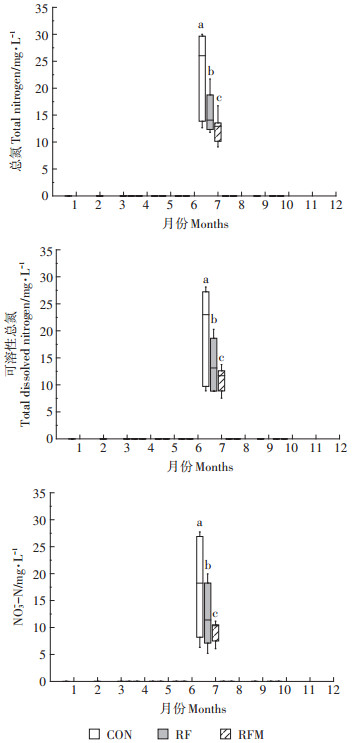
|
图 5 不同月份径流水中总氮、可溶性总氮、硝态氮浓度变化 Figure 5 Dynamics of total nitrogen(TN), total dissolved nitrogen (TDN)and NO3--N concentration in runoff water during the different months |
CON、RF和RFM处理总氮径流损失量分别为0.10、0.07 kg·hm-2和0.05 kg·hm-2(图 6),化肥减量替代降低了总氮流失量。其中可溶性总氮、NO3--N和NH4+-N分别占总氮流失量的86.60%、73.30%和5.01%。NO3--N是径流水中氮素流失的主要形态。
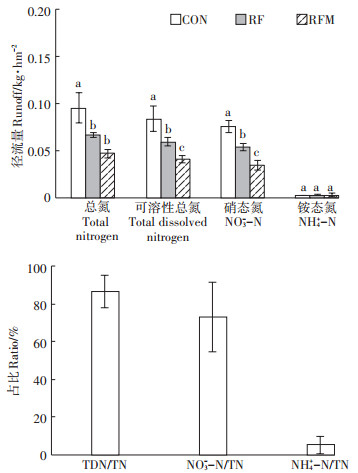
|
图 6 土壤总氮、可溶性总氮、硝态氮和铵态氮年均径流损失量 Figure 6 Average annual runoff loss of total nitrogen(TN), total dissolved nitrogen (TDN), NO3--N and NO4+-N in soil |
CON、RF和RFM处理氮淋溶表观流失率分别为4.19%、4.07%和3.32%(图 7),氮径流表观流失率分别为0.02%、0.02%和0.01%,化肥减量替代降低了氮素流失。氮淋溶和径流表观流失率分别为3.86%和0.02%,与径流相比,淋溶是氮素流失的主要途径。CON、RF和RFM处理水体氮排放强度分别为1.17、0.82 kg N·Mg-1和0.66 kg N·Mg-1(图 7)。化肥减量和化肥减量替代显著降低了水体氮排放强度,其中以化肥减量替代效果最为显著,降低了43.59%。

|
图 7 不同处理淋溶、径流氮表观流失率和水体氮排放强度 Figure 7 Apparent nitrogen loss ratio of leaching and runoff, and nitrogen emission intensity via (leaching and runoff)water of different treatments |
化肥是农田氮素输入的主要来源,灌溉和降雨分别占农田氮输入的5.69%~12.74%和0.65%~7.46%(图 8)。作物吸氮量为296~396 kg·hm-2,是农田氮素输出的主要形式,占总氮输入的54.95%~83.63%。氮淋溶占总氮输出的1.21%~9.88%,而氮径流流失最高占比仅为0.04%。作物携出是农田氮素主要输出方式,但各处理间并无显著差异。CON、RF和RFM处理年平均氮盈余量分别为218.06、72.56 kg·hm-2和96.20 kg·hm-2,CON处理显著增加了土壤氮盈余量。与CON处理相比,RF和RFM处理土壤氮盈余分别降低了66.72%和55.88%(P<0.05)(图 8)。相较于RF和RFM,CON处理呈现出更高的氮淋溶和径流流失风险。
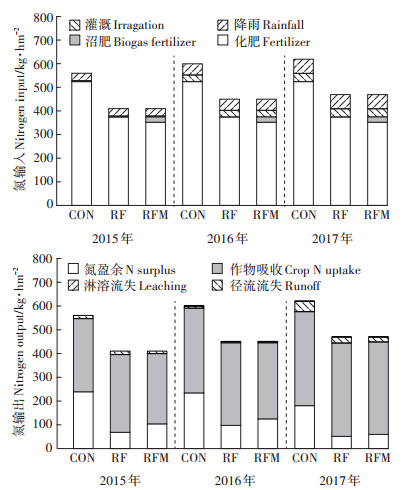
|
图 8 不同年份农田氮素输入和输出量变化 Figure 8 Changes of nitrogen input and output in cropland in different years |
本研究中常规施肥处理与减量施肥处理相比,小麦和玉米产量并没有显著变化,但前者盈余量远高于后者。这一结果表明,区域施肥不合理条件下,适当降低肥料投入可以保证作物产量,降低氮盈余量[6, 21]。化肥的施用量远超作物需求量,不仅对作物产量增加无益处,还会大幅增加土壤中氮的盈余,造成氮资源浪费[22]。本研究发现,与单施化肥相比,沼液与化肥配施增加了玉米产量,但效果并不显著,这与有机肥的替代比例有关[23]。王桂良等[11]研究指出,用沼液替代30%的化肥氮未能显著提高小麦产量,且随着沼液替代量的增加,小麦产量呈现先增加后降低的趋势。也有研究表明[24]沼液替代50%化肥并未显著增加作物产量。合适的有机肥替代量应取决于土壤肥力,肥力较贫瘠的土壤,应采用较低的有机替代比例,以满足作物对养分的即时需求,减少微生物生长繁殖所消耗的养分;肥力较高的土壤,可采用较高的有机肥替代比例,以提高土壤微生物活性,活化土壤养分,同步提高作物产量和土壤肥力[25]。
3.2 化肥减量配施沼液对土壤氮素流失和氮平衡的影响地表径流和地下淋溶是农田氮素流失的两个主要途径。灌溉和降雨是促使土壤产生淋溶和径流的主要驱动力,连续强降雨更易增加淋溶水中氮素浓度,加大氮素流失[26-28]。肥料氮是氮素流失的物质基础,施肥量的高低是造成氮素流失量大小的重要因素[29-32]。例如,王立刚等[33]在山东桓台的研究结果指出,当氮肥投入量高于300 kg·hm-2时作物产量不再增加,但氮淋失量却急剧升高。高施肥量引起氮素流失量增加主要是由于氮肥大量投入到农田后,未被植物吸收利用的氮素残留在土壤中,在干旱地区经过硝化作用,使得残留在土壤中的无机氮多以NO3--N的形式存在,极易随土壤水向下迁移[16]。本研究在目前华北平原常规施氮量基础上,小麦和玉米季氮肥分别减施75 kg·hm-2下,实现了总氮淋失量降低30.58%,淋溶液和径流水中的总氮浓度也分别显著降低了31.45%和32.92%。本研究各处理间淋溶水量并无显著差异,进一步表明合理的施肥管理措施是降低氮淋失的主要途径。
虽然地下淋溶和地表径流是氮随水流失的两个主要途径,但是由于本研究所处华北平原,研究区内仅有2017年作物生育期年降雨量超过了450 mm,且单次降雨强度较弱,因此区域内地表径流发生几率较低[34-35]。研究期间,试验区3年仅产生了2次径流,与径流相比,淋溶是该地区氮素流失的主要途径。常规施肥处理氮年均淋失量为22.01 kg·hm-2,表观淋失率为4.19%,显著高于径流损失。Ju等[36]的研究也得出了相似的结论,其指出华北平原小麦季氮素在1 m土层中的淋失率约为2.7%,玉米季约为12.1%。
相较于化肥减量,化肥减量替代能进一步有效降低总氮流失量[37-40]。已有研究表明,商品有机肥配施能显著降低土壤总氮和硝态氮的淋失,且随着有机肥配施比例的增加,土壤氮淋失量明显下降[40]。这可能是由于有机肥中含有的微生物等在作物生长初期可以固定施入土壤中的盈余氮素,并在作物生长中后期通过矿化作用再将氮释放,从而减少了硝态氮向深层土壤的淋失[41]。本研究使用的是沼肥,替代比例为10%,在此替代比例下,沼肥替代处理仍较等量化肥处理总氮淋失量减少了18.49%,表观流失率降低了18.43%。沼肥施入土壤后,其所带入的水分、铵态氮和总氮主要集中于0~5 cm表层土壤,在深层土壤中并无显著差异[42],且沼肥施入提高了生育期土壤固氮菌的数量,有助于减少氮流失[43]。Du等[15]研究表明,沼液中含有大量的铵态氮和可以矿化为铵态氮的有机氮复合化合物,因此沼液替代化肥可减少土壤氮素淋失率,但不同的替代比例效果不同。由于沼液中氮的形态主要是铵态氮,沼液替代化肥施入农田后,在降低氮淋溶的同时可能会提高农田氨挥发的排放量[10],且沼液配施增加了土壤水分含量,可能对氮的反硝化有促进作用[44]。如黄红英等[45]研究指出,沼液全量替代提高了农田N2O排放量。此外还需注意沼液大量还田所带入的抗生素以及重金属污染等问题[46]。
4 结论(1)淋溶是华北平原氮素流失的主要途径。氮素流失的主要形态是硝态氮,分别占淋溶和径流总氮流失量的66.31%和73.33%。
(2)根据作物氮素需求适当降低化肥氮投入可以在保证作物产量的同时显著降低氮素流失的环境风险。
(3)在一些养殖集中区域,在减施化肥的基础上适当进行化肥替代,可进一步降低氮素流失造成的环境风险。而合理的沼液替代比例是保证作物产量和管控环境风险的关键,也是未来进一步探究的重点。
| [1] |
Erisman J W, Sutton M A, Galloway J, et al. How a century of ammonia synthesis changed the world[J]. Nature Geoscience, 2008, 1(10): 636-639. DOI:10.1038/ngeo325 |
| [2] |
王善高, 田旭, 周应恒, 等. 中国农业化肥施用量增长原因分解及其消减潜力分析[J]. 生态经济, 2019, 35(3): 115-121. WANG Shan-gao, TIAN Xu, ZHOU Ying-heng. Analysis on the reasons for increase of agricultural chemical fertilizer in China and the potential of reducing it[J]. Ecological Economy, 2019, 35(3): 115-121. |
| [3] |
张卫峰, 马林, 黄高强, 等. 中国氮肥发展、贡献和挑战[J]. 中国农业科学, 2013, 46(15): 3161-3171. ZHANG Wei-feng, MA Lin, HUANG Gao-qiang, et al. The development and contribution of nitrogenous fertilizer in China and challenges faced by the country[J]. Scientia Agricultura Sinica, 2013, 46(15): 3161-3171. DOI:10.3864/j.issn.0578-1752.2013.15.010 |
| [4] |
Vitousek P M, Naylor R, Crews T, et al. Nutrient imbalances in agricultural development[J]. Science, 2009, 324(5934): 1519-1520. DOI:10.1126/science.1170261 |
| [5] |
段然, 汤月丰, 文炯, 等. 减量施肥对湖垸旱地作物产量及氮磷径流损失的影响[J]. 中国生态农业学报, 2013, 21(5): 536-543. DUAN Ran, TANG Yue-feng, WEN Jiong, et al. Effect of reducing fertilizer application on crop yield and nitrogen and phosphorus loss in runoff from embankment upland in Dongting Lake region[J]. Chinese Journal of Eco-Agriculture, 2013, 21(5): 536-543. |
| [6] |
赵亚南, 宿敏敏, 吕阳, 等. 减量施肥下小麦产量、肥料利用率和土壤养分平衡[J]. 植物营养与肥料学报, 2017, 23(4): 864-873. ZHAO Ya-nan, SU Min-min, LÜ Yang, et al. Wheat yield, nutrient use efficiencies and soil nutrient balance under reduced fertilizer rate[J]. Journal of Plant Nutrition and Fertilizer, 2017, 23(4): 864-873. |
| [7] |
武淑霞, 刘宏斌, 黄宏坤, 等. 我国畜禽养殖粪污产生量及其资源化分析[J]. 中国工程科学, 2018, 20(5): 103-111. WU Shu-xia, LIU Hong-bin, HUANG Hong-kun, et al. Analysis on the amount and utilization of manure in livestock and poultry breeding in China[J]. Engineering Sciences, 2018, 20(5): 103-111. |
| [8] |
Zhong W H, Gu T, Wang W, et al. The effects of mineral fertilizer and organic manure on soil microbial community and diversity[J]. Plant and Soil, 2010, 326(1/2): 511-522. |
| [9] |
Celik I, Ortas I, Kilic S. Effects of compost, mycorrhiza, manure and fertilizer on some physical properties of a Chromoxerert soil[J]. Soil and Tillage Research, 2004, 78(1): 59-67. DOI:10.1016/j.still.2004.02.012 |
| [10] |
吴华山, 郭德杰, 马艳, 等. 猪粪沼液施用对土壤氨挥发及玉米产量和品质的影响[J]. 中国生态农业学报, 2012, 20(2): 163-168. WU Hua-shan, GUO De-jie, MA Yan, et al. Effects of pig manurebiogas slurry application on soil ammonia volatilization and maize output and quality[J]. Chinese Journal of Eco-Agriculture, 2012, 20(2): 163-168. |
| [11] |
王桂良, 张家宏, 王守红, 等. 沼液替代化肥氮对冬小麦产量、品质及生长发育的影响[J]. 农业资源与环境学报, 2018, 35(5): 467-475. WANG Gui-liang, ZHANG Jia-hong, WANG Shou-hong, et al. Effects of chemical fertilizer nitrogen substitution by biogas slurry on yield, quality and growth characteristics of winter wheat[J]. Journal of Agricultural Resources and Environment, 2018, 35(5): 467-475. |
| [12] |
倪亮, 孙广辉, 罗光恩, 等. 沼液灌溉对土壤质量的影响[J]. 土壤, 2008, 40(4): 608-611. NI Liang, SUN Guang-hui, LUO Guang-en, et al. Effect of marsh gas sewage irrigation on soil quality[J]. Soils, 2008, 40(4): 608-611. DOI:10.3321/j.issn:0253-9829.2008.04.019 |
| [13] |
王靖荃, 谷端银, 于晓东, 等. 沼液部分替代化肥在日光温室秋番茄上的应用效果[J]. 应用生态学报, 2019, 30(1): 243-250. WANG Jing-quan, GU Duan-yin, YU Xiao-dong, et al. Application effects of biogas slurry partly substituting for chemical fertilizer on autumn tomato production in winter-solar greenhouse[J]. Chinese Journal of Applied Ecology, 2019, 30(1): 243-250. |
| [14] |
Yang X L, Lu Y L, Tong Y A, et al. A 5-year lysimeter monitoring of nitrate leaching from wheat-maize rotation system:Comparison between optimum N fertilization and conventional farmer N fertilization[J]. Agriculture, Ecosystems & Environment, 2015, 199: 34-42. |
| [15] |
Du H Y, Gao W X, Li J J, et al. Effects of digested biogas slurry application mixed with irrigation water on nitrate leaching during wheatmaize rotation in the North China Plain[J]. Agricultural Water Management, 2019, 213: 882-893. DOI:10.1016/j.agwat.2018.12.012 |
| [16] |
李祯, 史海滨, 李仙岳, 等. 农田硝态氮淋溶规律对不同水氮运筹模式的响应[J]. 水土保持学报, 2017, 31(1): 310-317. LI Zhen, SHI Hai-bin, LI Xian-yue, et al. Response of the nitrate nitrogen leaching law to different water-nitrogen management patterns in farmland[J]. Journal of Soil and Water Conservation, 2017, 31(1): 310-317. |
| [17] |
宁建凤, 邹献中, 杨少海, 等. 有机无机氮肥配施对土壤氮淋失及油麦菜生长的影响[J]. 农业工程学报, 2007, 23(11): 95-100. NING Jian-feng, ZOU Xian-zhong, YANG Shao-hai, et al. Effects of combined application of organic and inorganic nitrogen fertilizer on the soil nitrogen leaching and the growth of leaf-used lettuce[J]. Transactions of the Chinese Society of Agricultural Engineering, 2007, 23(11): 95-100. DOI:10.3321/j.issn:1002-6819.2007.11.016 |
| [18] |
习斌, 翟丽梅, 刘申, 等. 有机无机肥配施对玉米产量及土壤氮磷淋溶的影响[J]. 植物营养与肥料学报, 2015, 21(2): 326-335. XI Bin, ZHAI Li-mei, LIU Shen, et al. Effects of combination of organic and inorganic fertilization on maize yield and soil nitrogen and phosphorus leaching[J]. Journal of Plant Nutrition and Fertilizer, 2015, 21(2): 326-335. |
| [19] |
何石福, 荣湘民, 李艳, 等. 有机肥替代和稻草覆盖对中南丘陵茶园氮磷径流损失的影响[J]. 水土保持学报, 2017, 31(5): 120-126. HE Shi-fu, RONG Xiang-min, LI Yan, et al. Effects of organic manure substitution and straw mulching on nitrogen and phosphorus runoff loss in Hongnan Hilly tea plantation[J]. Journal of Soil and Water Conservation, 2017, 31(5): 120-126. |
| [20] |
鲁如坤. 土壤农业化学分析方法[M]. 北京: 中国农业科技出版社, 2000. LU Ru-kun. The analytic method of soil and agricultural chemistry[M]. Beijing: China Agricultural Science and Technology Press, 2000. |
| [21] |
李焕春, 赵娜, 莎娜, 等. 滴灌条件下减量施肥对玉米产量及肥料利用率的影响[J]. 北方农业学报, 2017, 45(6): 39-43. LI Huan-chun, ZHAO Na, SHA Na, et al. Effects of reduced fertilization on yield and fertilizer use efficiency of maize under drip irrigation[J]. Journal of Northern Agriculture, 2017, 45(6): 39-43. DOI:10.3969/j.issn.2096-1197.2017.06.07 |
| [22] |
郭智, 刘红江, 张岳芳, 等. 不同施肥模式对菜地氮素径流损失与表观平衡的影响[J]. 水土保持学报, 2018, 32(4): 37-42. GUO Zhi, LIU Hong-jiang, ZHANG Yue-fang, et al. Effects of different fertilization modes on nitrogen loss by surface runoff and the apparent nitrogen balance in the vegetable fields of Taihu Lake region, China[J]. Journal of Soil and Water Conservation, 2018, 32(4): 37-42. |
| [23] |
黄红英, 曹金留, 常志州, 等. 猪粪沼液施用对稻、麦产量和氮磷吸收的影响[J]. 土壤, 2013, 45(3): 412-418. HUANG Hong-ying, CAO Jin-liu, CHANG Zhi-zhou, et al. Effects of digested pig slurry application on yields, nitrogen and phosphorous uptakes by rice and wheat[J]. Soils, 2013, 45(3): 412-418. DOI:10.3969/j.issn.0253-9829.2013.03.005 |
| [24] |
孙国峰, 周炜, 何加骏, 等. 猪粪沼液施用后土壤理化性状及小麦产量的变化[J]. 江苏农业学报, 2012, 28(5): 1054-1060. SUN Guo-feng, ZHOU Wei, HE Jia-jun, et al. Changes of soil physical and chemical properties and wheat yield after swine manure or slurry application[J]. Jiangsu J of Agr Sci, 2012, 28(5): 1054-1060. |
| [25] |
吕凤莲, 侯苗苗, 张弘弢, 等. 塿土冬小麦-夏玉米轮作体系有机肥替代化肥比例研究[J]. 植物营养与肥料学报, 2018, 24(1): 22-32. LÜ Feng-lian, HOU Miao-miao, ZHANG Hong-tao, et al. Replacement ratio of chemical fertilizer nitrogen with manure under the winter wheat-summer maize rotation system in Lou soil[J]. Journal of Plant Nutrition and Fertilizers, 2018, 24(1): 22-32. |
| [26] |
Yang X L, Lu Y L, Ding Y, et al. Optimising nitrogen fertilisation:A key to improving nitrogen-use efficiency and minimising nitrate leaching losses in an intensive wheat/maize rotation(2008-2014)[J]. Field Crops Research, 2017, 206: 1-10. DOI:10.1016/j.fcr.2017.02.016 |
| [27] |
Zhang Q W, Liu D H, Cheng S H, et al. Combined effects of runoff and soil erodibility on available nitrogen losses from sloping farmland affected by agricultural practices[J]. Agricultural Water Management, 2016, 176: 1-8. DOI:10.1016/j.agwat.2016.05.018 |
| [28] |
Shan L N, He Y F, Chen J, et al. Nitrogen surface runoff losses from a Chinese cabbage field under different nitrogen treatments in the Taihu Lake Basin, China[J]. Agricultural Water Management, 2015, 159: 255-263. DOI:10.1016/j.agwat.2015.06.008 |
| [29] |
王志国, 刘培, 邵宇婷, 等. 减量施氮与间作大豆对华南地区甜玉米农田氮平衡的影响[J]. 中国生态农业学报, 2018, 26(11): 1643-1652. WANG Zhi-guo, LIU Pei, SHAO Yu-ting, et al. Effect of nitrogen reduction and soybean intercropping on nitrogen balance in sweet maize fields in south China[J]. Chinese Journal of Eco-Agriculture, 2018, 26(11): 1643-1652. |
| [30] |
王伟, 梁斌, 康凌云, 等. 氮素供应与秸秆还田对设施菜田土壤硝态氮淋溶的动态影响[J]. 水土保持学报, 2015, 29(4): 61-65. WANG Wei, LIANG Bin, KANG Ling-yun, et al. Impact of nitrogen supply and straw application on dynamics of soil nitrate leaching in greenhouse vegetable field[J]. Journal of Soil and Water Conservation, 2015, 29(4): 61-65. |
| [31] |
张贵龙, 任天志, 李志宏, 等. 施氮量对白萝卜硝酸盐含量和土壤硝态氮淋溶的影响[J]. 植物营养与肥料学报, 2009, 15(4): 877-883. ZHANG Gui-long, REN Tian-zhi, LI Zhi-hong, et al. Effects of nitrogen fertilization on nitrate content of radish(Raphanus sativus L.)and soil nitrate leaching[J]. Plant Nutrition and Fertilizer Science, 2009, 15(4): 877-883. DOI:10.3321/j.issn:1008-505X.2009.04.021 |
| [32] |
Armour J D, Nelson P N, Daniells J W, et al. Nitrogen leaching from the root zone of sugarcane and bananas in the humid tropics of Australia[J]. Agriculture, Ecosystems & Environment, 2013, 180: 68-78. |
| [33] |
王立刚, 李虎, 杨黎, 等. 冬小麦/夏玉米轮作系统不同施氮量的长期环境效应及区域氮调控模拟[J]. 中国农业科学, 2013, 46(14): 2932-2941. WANG Li-gang, LI Hu, YANG Li, et al. Simulation of long-term and regional environmental effects of different N applications in the winter wheat/summer maize system[J]. Scientia Agricultura Sinica, 2013, 46(14): 2932-2941. DOI:10.3864/j.issn.0578-1752.2013.14.009 |
| [34] |
Tan D H, Jiang L H, Tan S Y, et al. An in situ study of inorganic nitrogen flow under different fertilization treatments on a wheat-maize rotation system surrounding Nansi Lake, China[J]. Agricultural Water Management, 2013, 123: 45-54. DOI:10.1016/j.agwat.2013.03.011 |
| [35] |
Wang R, Liu Z F, Yao Z J, et al. Modeling the risk of nitrate leaching and nitrate runoff loss from intensive farmland in the Baiyangdian Basin of the North China Plain[J]. Environmental Earth Sciences, 2014, 72(8): 3143-3157. DOI:10.1007/s12665-014-3219-4 |
| [36] |
Ju X T, Xing G X, Chen X P, et al. Reducing environmental risk by improving N management in intensive Chinese agricultural systems[J]. Proceedings of the National Academy of Sciences, 2009, 106(9): 3041-3046. DOI:10.1073/pnas.0813417106 |
| [37] |
高伟, 李明悦, 高宝岩, 等. 有机无机肥料配合施用对设施黄瓜产量、氮素累积及硝酸盐淋溶的影响[J]. 华北农学报, 2015, 30(4): 188-193. GAO Wei, LI Ming-yue, GAO Bao-yan, et al. Effects of combined application of organic manure and chemical fertilizers on yield and nitrate accumulation of cucumber and nitrate leaching under greenhouse condition[J]. Acta Agriculturae Boreall-Sinica, 2015, 30(4): 188-193. |
| [38] |
刘汝亮, 张爱平, 李友宏, 等. 长期配施有机肥对宁夏引黄灌区水稻产量和稻田氮素淋失及平衡特征的影响[J]. 农业环境科学学报, 2015, 34(5): 947-954. LIU Ru-liang, ZHANG Ai-ping, LI You-hong, et al. Rice yield, nitrogen use efficiency(NUE)and nitrogen leaching losses as affected by long-term combined applications of manure and chemical fertilizers in Yellow River irrigated region of Ningxia, China[J]. Journal of AgroEnvironment Science, 2015, 34(5): 947-954. |
| [39] |
张玉平, 荣湘民, 刘强, 等. 有机无机肥配施对旱地作物养分利用率及氮磷流失的影响[J]. 水土保持学报, 2013, 27(3): 44-48. ZHANG Yu-ping, RONG Xiang-min, LIU Qiang, et al. Effects of combination of organic and inorganic fertilizer on crop nutrient utilization rate nitrogen and phosphorus loss in dry land[J]. Journal of Soil and Water Conservation, 2013, 27(3): 44-48. |
| [40] |
宁建凤, 徐培智, 杨少海, 等. 有机无机肥配施对菜地土壤氮素径流流失的影响[J]. 水土保持学报, 2011, 25(3): 17-21. NING Jian-feng, XU Pei-zhi, YANG Shao-hai, et al. Effects of combined application of organic and inorganic fertilizer on soil nitrogen runoff in vegetable field[J]. Journal of Soil and Water Conservation, 2011, 25(3): 17-21. |
| [41] |
马臣, 刘艳妮, 梁路, 等. 有机无机肥配施对旱地冬小麦产量和硝态氮残留淋失的影响[J]. 应用生态学报, 2018, 29(4): 1240-1248. MA Chen, LIU Yan-ni, LIANG Lu, et al. Effects of combined application of chemical fertilizer and organic manure on wheat yield and leaching of residual nitrate-N in dryland soil[J]. Chinese Journal of Applied Ecology, 2018, 29(4): 1240-1248. |
| [42] |
王忠江, 蔡康妮, 王丽丽, 等. 沼肥表施对土壤氮素动态分布及氨挥发的影响[J]. 农业机械学报, 2014, 45(7): 139-143. WANG Zhong-jiang, CAI Kang-ni, WANG Li-li, et al. Influence of surface application of biogas slurry on ammonia volatilization and dynamic distribution of soil nitrogen[J]. Transactions of the Chinese Society of Agricultural Mechinery, 2014, 45(7): 139-143. |
| [43] |
李轶, 易维明, 刘庆玉. 施用沼肥对设施土壤固氮菌影响的研究[J]. 可再生能源, 2009, 27(2): 43-45. LI Yi, YI Wei-ming, LIU Qing-yu. Effects of applying biogas fertilizer on nitrogen-fixation bacteria in greenhouse soil[J]. Renewable Energy Resources, 2009, 27(2): 43-45. DOI:10.3969/j.issn.1671-5292.2009.02.011 |
| [44] |
郑欠, 丁军军, 李玉中, 等. 土壤含水量对硝化和反硝化过程N2O排放及同位素特征值的影响[J]. 中国农业科学, 2017, 50(24): 4747-4758. ZHENG Qian, DING Jun-jun, LI Yu-zhong, et al. The effects of soil water content on N2O emissions and isotopic signature of nitrification and denitrification[J]. Scientia Agricultura Sinica, 2017, 50(24): 4747-4758. DOI:10.3864/j.issn.0578-1752.2017.24.008 |
| [45] |
黄红英, 曹金留, 靳红梅, 等. 猪粪沼液施用对稻麦轮作系统土壤氧化亚氮排放的影响[J]. 农业环境科学学报, 2011, 30(11): 2353-2361. HUANG Hong-ying, CAO Jin-liu, JIN Hong-mei, et al. Influence of application of digested pig slurry on nitrous oxide emission under rice-wheat rotation system[J]. Journal of Agro-Environment Science, 2011, 30(11): 2353-2361. |
| [46] |
尹冬雪, 刘伟, 周罕觅, 等. 沼液农用综合利用研究进展[J]. 安徽农业科学, 2018, 46(3): 15-17. YIN Dong-xue, LIU Wei, ZHOU Han-mi, et al. Research progress of biogas slurry for agricultural comprehensive utilization[J]. J Anhui Agric Sci, 2018, 46(3): 15-17. DOI:10.3969/j.issn.0517-6611.2018.03.007 |
 2020, Vol. 39
2020, Vol. 39



